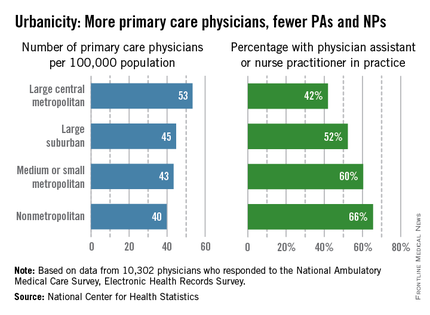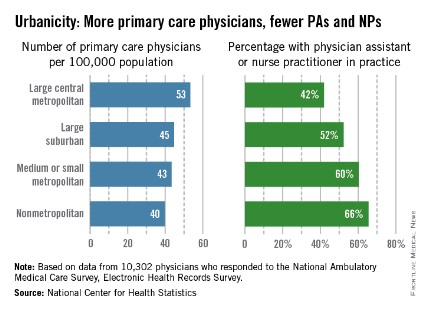User login
The supply of primary care physicians is greatest in large metropolitan areas, but those big-city PCPs are the least likely to work with physician assistants and nurse practitioners, the National Center for Health Statistics said in a report released May 8.
In 2012, there was a significant trend toward greater availability of PCPs with increased urbanicity, with large central metropolitan areas having 53 PCPs per 100,000 population, large suburban areas at 45 per 100,000, medium or small metropolitan areas at 43 per 100,000, and nonmetropolitan areas at 40 per 100,000, according to NCHS.
The trend, though still significant, reversed for the percentage of primary care practices with PAs or NPs. In nonmetropolitan areas, there was a PA or NP in 66% of offices, compared with 60% for small or medium-sized cities, 52% for large suburbs, and 42% for large central cities, the report showed.
For the analysis, PCPs included those specializing in family and general medicine, internal medicine, pediatrics, and geriatrics. The data used came from 10,302 physicians who responded to the National Ambulatory Medical Care Survey, Electronic Health Records Survey.

The supply of primary care physicians is greatest in large metropolitan areas, but those big-city PCPs are the least likely to work with physician assistants and nurse practitioners, the National Center for Health Statistics said in a report released May 8.
In 2012, there was a significant trend toward greater availability of PCPs with increased urbanicity, with large central metropolitan areas having 53 PCPs per 100,000 population, large suburban areas at 45 per 100,000, medium or small metropolitan areas at 43 per 100,000, and nonmetropolitan areas at 40 per 100,000, according to NCHS.
The trend, though still significant, reversed for the percentage of primary care practices with PAs or NPs. In nonmetropolitan areas, there was a PA or NP in 66% of offices, compared with 60% for small or medium-sized cities, 52% for large suburbs, and 42% for large central cities, the report showed.
For the analysis, PCPs included those specializing in family and general medicine, internal medicine, pediatrics, and geriatrics. The data used came from 10,302 physicians who responded to the National Ambulatory Medical Care Survey, Electronic Health Records Survey.

The supply of primary care physicians is greatest in large metropolitan areas, but those big-city PCPs are the least likely to work with physician assistants and nurse practitioners, the National Center for Health Statistics said in a report released May 8.
In 2012, there was a significant trend toward greater availability of PCPs with increased urbanicity, with large central metropolitan areas having 53 PCPs per 100,000 population, large suburban areas at 45 per 100,000, medium or small metropolitan areas at 43 per 100,000, and nonmetropolitan areas at 40 per 100,000, according to NCHS.
The trend, though still significant, reversed for the percentage of primary care practices with PAs or NPs. In nonmetropolitan areas, there was a PA or NP in 66% of offices, compared with 60% for small or medium-sized cities, 52% for large suburbs, and 42% for large central cities, the report showed.
For the analysis, PCPs included those specializing in family and general medicine, internal medicine, pediatrics, and geriatrics. The data used came from 10,302 physicians who responded to the National Ambulatory Medical Care Survey, Electronic Health Records Survey.

